1-13 November 2013. Our first introduction to Patagonia was all glaciers and mountains and howling winds.
We flew from Buenos Aires to El Calfate. We had allowed for three days there, and four in El Chalten, thinking that in both places we’d have a rest day. Ha! Not even maybe. There was so much more to see and do than we’d expected.
It used to be possible to take a boat all the way up Lago Argentino right to the face of Upsala Glacier, but the channel to it is blocked by ten kilometers of icebergs that have broken off from the front of it, though not necessarily due to the fact that it’s retreating. One theory posits that the land is dropping beneath the weight of the glacier and that this caused the breakup. Some glaciers in the Southern Patagonia Ice Field are stable, and some are growing.
Forty minutes or more, the boat drifting slowly across the wall of icebergs and back again, careful not to get too close, we didn’t want to be the second Titanic. Staring. Icebergs are amazing. So huge and still, but always changing and moving. You can stare at them for hours. It’s almost as if they have life.
From the boat to land for a four-wheel drive across country to a view of the glacier itself. An hour or more of bumping along. It is wild country. There’s often not even actually a track to travel on. The land formations are other-worldly, surreal.
The “road” to the glacier view point.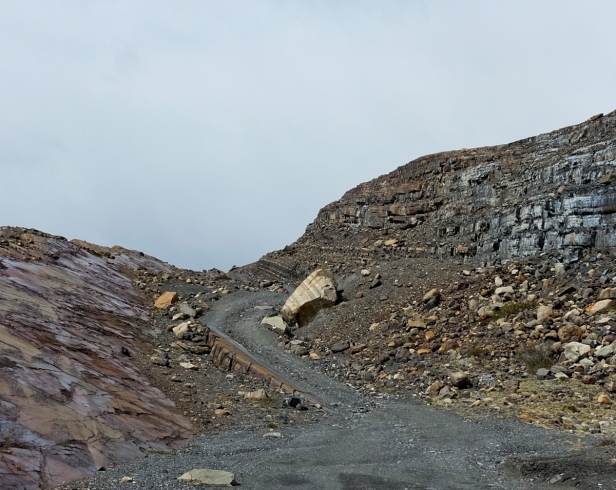

Upsala Glacier in the distance on a cold stormy windy day. It is sixty kilometers long.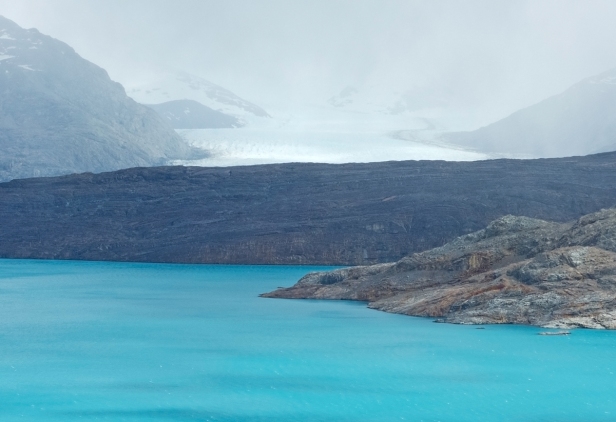
One of the guides climbed down the cliff a little way and had each of us in turn stand on the top of the cliff and, with our arms folded, lean into him. He then instructed us to stand upright and spread our arms. As we did it the wind literally knocked us over. Good thing the other guide was behind to catch us. A wind so strong it can knock you over. A wind so strong your camera literally shudders – the ultimate camera shake. Impossible to hold it still.
El Chalten, a little to the north of El Calafate is the gateway to trekking in the southern Andes in Argentina. What a sweet little gem of a town, and trails leading right from it – just walk on down the street towards those glorious mountains.
Always in Patagonia weather is a factor, especially in the mountains. We arrived at about noon by bus from El Calafate on a rare glorious clear sunny day, trundled ourselves and our cases to our hotel, picking up some sandwiches on the way, dropped our bags and headed straight out on the trail to Mount Fitz Roy. When the weather is like this you just go, because it could be weeks before another sunny cloudless day comes around again. Oh and what a sweet reward we received.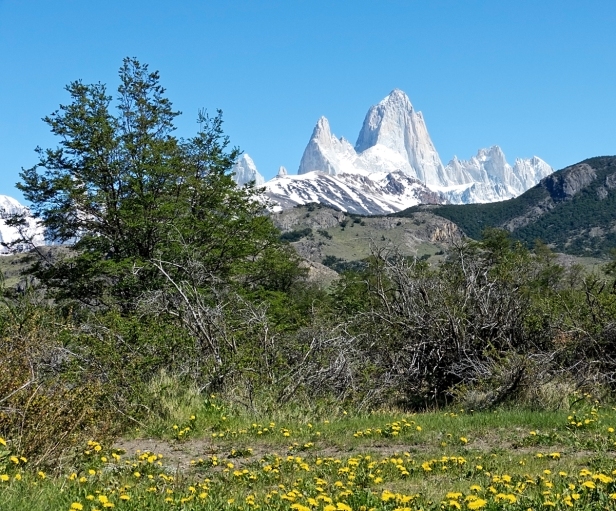
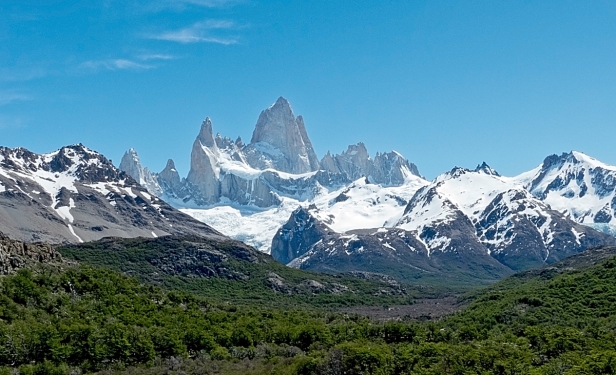

By the next morning the weather had already changed but we headed out anyway, this time taking the trail to Cerro Torre (Tower Mountain) and walking quite slowly through forests and meadows covered in bright dandelions. I heard a noise in the trees and stopped. A pair of woodpeckers! Magic. Who cares if the mountains are a bit socked in, we got to see woodpeckers.

And, indeed Cerro Torre was covered in clouds but two days later we went back along the same trail and were rewarded with a brief glimpse of the three famous towers.

The Southern Patagonia Ice Field is the third biggest ice field in the world after Antarctica and Greenland. It’s enormous, and dozens of glaciers flow from it. Okay I admit it, until I went to Patagonia I didn’t really know what a glacier is. So for all of you who need a little help a glacier is this: up in those mountains it snows just about year round. It’s so cold the snow never melts. It builds up and builds up, becomes compacted and turns to ice. It’s up in the mountains. High mountains, with steep sides. And gravity takes over. The ice field flows down the mountainsides wherever it can, exactly like a river would.
Perito Merino Glacier, thirty kilometres long.
Our first trip to Perito Merino Glacier, which flows into Lago Argentino, included a one-hour boat trip on the lake right up to the face of the glacier, and about three hours wandering along the viewing platforms in front of it. We were excited about the boat trip, excited to be getting right up close to it. But three hours to look at it from the platforms. Really? What would we do for three hours? We had no idea how absolutely riveting it would be. Who would have thought? Viewing a glacier up close is riveting. Because you never know when a giant chunk is going to break off and go crashing into the water. And there are internal movements all the time that send out loud booms, and even the smaller pieces falling off make a very loud noise. It’s moving all the time and it’s not quiet about it. And you’re watching and watching and watching waiting for a really really big chunk to go crashing down. I saw it once. Don was looking away and missed it. By the time you hear the noise it’s all over.
The centre part of Perito Merino Glacier, where the movement is strongest, flows down at the rate of two to three metres per day. You look at and it appears to be stationary, and the only way you can tell it is moving is the frequent loud booms, and the chunks falling off the front. But if I had to choose just one word to describe the glacier, it would be majestic. It is huge, awe-inspiring, and truly majestic.
The wall of ice is 74 metres high above the water – about the height of a 24-story building – and has a total height of 170 metres. The wall of ice literally stops the lake.

It is five kilometres wide. 
And then we went trekking on it! I never thought I’d walk on a glacier. Don and I are so funny – we always initially say no the things we’ve never done before. I suppose there’s some fear of not being able to do it, or keep up, or something, and we’re almost always surrounded by teenage or twentysomething backpackers. When Don first saw the boat at Iguazu Falls he was very sure he was not going out in that boat. I was up for it, but the ice trekking not so much. It kinda scared me. I remember Don didn’t want to go swimming with the elephants in Laos, and I tried to chicken out at the last minute. Then we end up doing all these things anyway. And every time, without fail, it is the best. fun. ever. Every time.
Crampons strapped on, rambling stumbling, lurching, and at times actually just walking, over the top of a glacier. So much fun. Every now and then we’d find ourselves silly grinning at each other – we‘re wearing crampons and walking on a glacier! It ended, after an hour and a half, with a shot of Famous Grouse whiskey over glacier ice. Completely shocking. I hardly drink. I don’t like whiskey. I’ve never enjoyed a glass of whiskey so much. I had seconds, then pranced carefully cramponed my way off to solid ground.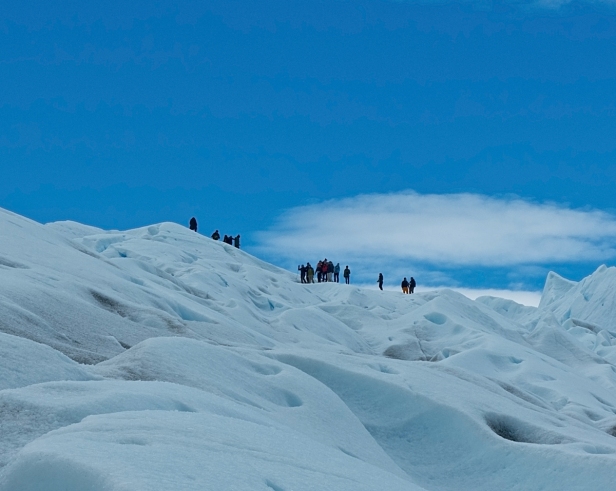
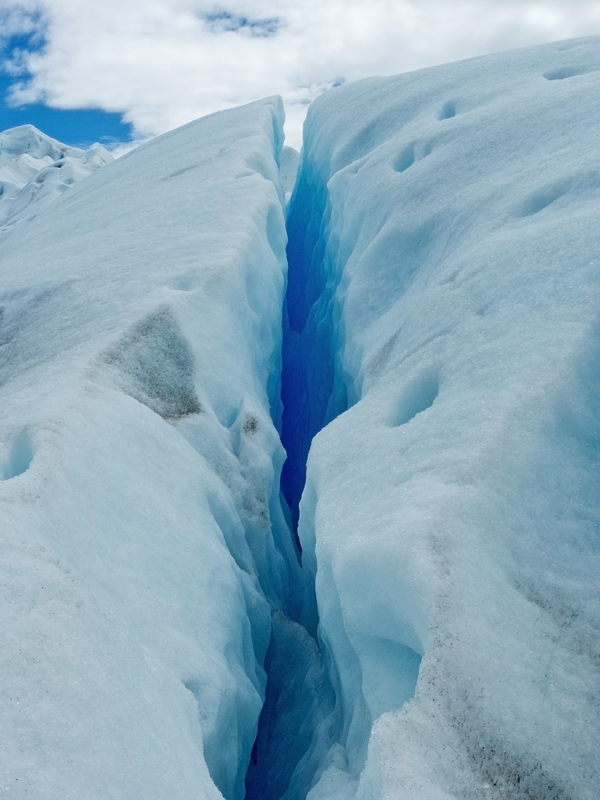


After ten days of travel and/or going out exploring every day we were beat. So far the weather had been our friend and there was so much we wanted to see and experience that we just kept going like crazy little energizer bunnies. We arrived in Puerto Natales, Chile by bus from El Calafate, Argentina, and collapsed. We both had colds and sore throats. The weather was still our friend. It howled a roaring freezing gale for two days and we had the perfect excuse to stay home and rest, which is what we needed most. Unfortunately we were in the shrieking shack (with apologies to J. K. Rowling). It was the wind that was shrieking, or was it the building that was protesting?
It puzzles me that in a land of freezing temperatures and howling gales buildings are not made airtight, there are no double-paned windows (or none that we ever saw anywhere), and no signs that clear plastic has ever been used to create double-panes (which everyone does automatically in the Yukon every winter). We liked our hotel for many reasons but it was so far from airtight that it might as well have had huge gaping holes in the walls. At the end of the hallway right by our room there was a door that was fitted so loosely in the frame that you could see daylight between the door and frame. The wind was screaming through at 50 km per hour straight off the glaciers. Despite the heating being on all the time our room was freezing. We used it only for sleeping. Which we did a lot during those two days. On the plus side there was a lovely comfortable warm-enough lounge just down the hall from our room where we sat when we weren’t sleeping, played on the Internet, caught up on photo editing and writing, and met some really great people. Wearing every layer of clothing we possessed we ventured out for meals into winds that would knock you down, literally staggering along the street. This was the town where we found the worst lasagna ever. Worst! Ever! But that’s for another post.
And then on the third day the sun came out. We had hoped to be able to do some trekking in Torres Del Paine National Park, but due to the previous two days we had to settle for a day tour. The place is so magnificent, and the day was so shiny and sunny, that we have no complaints.
First off we got to see llamas up close,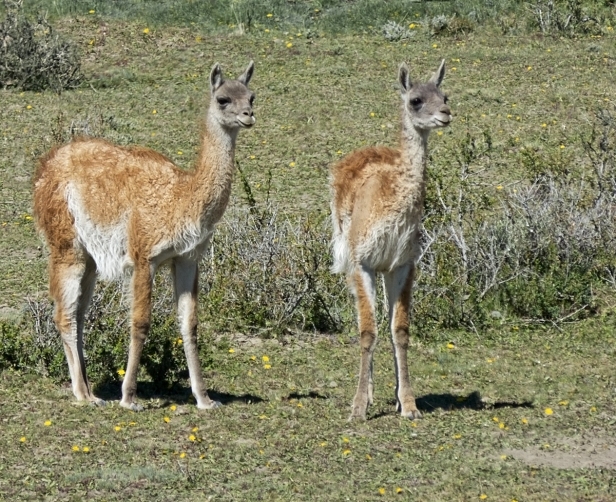

wild sweet peas and orchids,
a caracara falcon,
and parrots! Who knew? I thought parrots were tropical birds. 
There are no words for the landscape except to say it’s enough to make you swoon. So we did.


Next post: From Puerto Natales we travelled south to Punta Arenas, and Ushuaia, the most southern city in the world on the island of Tierra del Fuego. I’d tried to go to Tierra del Fuego in 1978 but gale force winds had shut down all the ferries. This trip I was hoping to make it on to the island.
All words and images by Alison Louise Armstrong unless otherwise noted.
© Alison Louise Armstrong and Adventures in Wonderland – a pilgrimage of the heart, 2010-2015.

I was going to say “I am blown away” but you and Don got more blown around!! This is simply incredible and makes me want to go back there even more.
LikeLike
Thanks Fiona. Yes, we were definitely blown around! I can understand why you would want to go back there – it’s all so beautiful.
LikeLike
your itinerary is just like ours…..isn’t it all marvelous!
LikeLike
Totally marvellous!
LikeLike
I need to talk to my husband to go to Patagonia, it definitely in my list. I wonder to do trekking on that glacier, does it require a certain level of fitness? as my husband always claim that he’s not fit enough to do this kind of holiday
LikeLike
Don and I are reasonably fit, though certainly not the fittest we’ve ever been. I would say for the short trek we did you don’t need to be super fit at all, just about regular healthy fitness.
LikeLike
Wow, you are brave going into the icy cold. Each year I try to get away from the cold at home, but you paint a beautiful enticing picture… now I may have to add another place to my list….
LikeLike
Oh we try to avoid the cold too, but Patagonia is so amazing it’s really worth it. We went from there to Mendoza and 2 weeks of hot hot days to re warm our bones.
LikeLike
Wow. What an adventure, and in a wild and beautiful place that the most of us will never see. I’ll bet you won’t complain when you move on to somewhere warmer.
LikeLike
We loved it when we moved on to somewhere warmer – 2 weeks in hot Mendoza in the desert. But we also loved Patagonia and wouldn’t have missed it for the world. It was all fabulous.
LikeLike
Wow, the pictures are amazing what a great experience.
LikeLike
Thanks Chris. It certainly was a great experience, and it’s all so beautiful it’s hard to take a bad photo there 🙂
LikeLike
Stunning views Alison
LikeLike
Thanks Anyes. Stunning place!
LikeLike
Coincidentally our friends climbed mt. Fitzroy and Larry painted this magnificent mountain as a gift to john for his birthday. Larry used a photo such as the one in your blog except it is viewed from the base of the mountain.
LikeLike
I’d love to see Larry’s painting – did he keep a photo of it? It’s such a stunning place, and knowing the way Larry paints I bet the painting was equally stunning.
Don’t think we’re quite up for climbing it. That would be quite the feat!
LikeLike
Superb post. There is almost everything in the post, Icebergs, mountains, beautiful birds… and we written too.
Thanks for sharing.
LikeLike
Thank you so much Sreejith. I’m glad you enjoyed it.
LikeLike
Yes Alison, this is one of the top post I read today.
LikeLike
Thanks 🙂
LikeLike
trekking on a glacier !! amazing .. 🙂 lovely pics of the glacier…. also loved the parrots .
LikeLike
Thanks humpty. Aren’t those parrots wonderful?! It’s the last thing we expected to see. And the trekking was a fabulous experience.
LikeLike
Wow, what an amazing adventure – the photos are outstanding!
Btw, I think those are vicunas not llamas. Yes, part of the llama or camelite family, but their wool is the finest and most prized in the world. I got to see some here in Peru. oxo
LikeLike
Thanks Surati. Yes, an amazing adventure, really fabulous.
Nope, they’re llamas. Vicuñas are smaller. There’s nothing in the photos to indicate their size.These are guanacos (i.e. Lama guanicoe) a bit smaller than the llamas you see at Macchu Picchu and domestic llamas, but bigger than vicunas. Alpacas fit in somewhere too, not sure where, maybe a bit smaller than guanacos. According to wiki (I know not the most reliable source) only guanacos and vicuñas are wild, and llamas and alpacas are domesticated. Certainly those I saw are not the traditional wooly beast we think of a llamas, but same family.
xox
LikeLike
The view is stunning, and the trekking sounds and looks quite scary!
LikeLike
It’s so very gorgeous and majestic there. We found ourselves blown away by the endless beauty! And the wind lol! The trekking was a little scary, but only mildly. To go downhill on ice with crampons you need strong knees. My right knee due to an old injury hasn’t much strength so the downhill parts were a bit tricky, but apart from that it was fine, and fun and quite exhilarating.
LikeLike
Absolutely absorbed in your adventures – Love your adorable mugs in the midst of such landscapes. I am toasting your glacier glasses of Grouse 🙂 with my peppermint tea!
LikeLike
Thanks Marga ❤ I'm so glad we have you along on the journey. I surprised myself with that whiskey since I rarely drink, and I don't like whiskey. But I sure enjoyed that one 🙂
xox
LikeLike
So exciting! Your descriptions of the glaciers were wonderful, and the pictures made me swoon!
LikeLike
Thanks Kelly. Swooning all round eh?! It’s such a beautiful place we were in heaven.xox
LikeLike
Trekking on a glacier sounds glorious and terrifying all at once. But the views you shot ensure that if I ever get the chance, I will say yes! to that experience. 🙂
LikeLike
You got it – glorious and terrifying all at once. Well not quite terrifying, but you sure needed to be paying attention. Yes! If you ever get the chance – go there and go ice trekking!
LikeLike
Your photos of the glaciers are fantastic. I really enjoyed just sitting looking at them. I saw and walked on Alberta glacier fields when I was young and travelling with my parents. At that age, though, it’s all like “oh, nice, now when can we….” — you know what I mean. Anyway, I was ‘gobsmacked’ when we got up close to the glaciers on our Alaska cruise. The ship spends a good half-day with a few different ones. The ship pulled up very close to the giant wall of one of them and we saw (and heard!!!) several huge calves break away. The sounds of a glacier are truly like nothing else. Like living beings, moaning and groaning and scraping and booming. It felt like they were telling their ancient story. I’m glad you’ve experienced this at last! Everybody should have the opportunity.
If you ever get a chance to see this documentary, do: http://www.chasingice.com/ We saw it on Netflix.
LikeLike
I know exactly what you mean about how you view things like glaciers when you’re young lol. I love how you describe glaciers, “like living beings, moaning and groaning and scraping and booming. . . . .telling their ancient story.” Love that. It’s exactly how they are. We’re glad we got to experience it too!
You’re the second person to recommend that movie – I obviously need to check it out.
LikeLike
My kind of remote! (grin) It appeared to me that the area was just begging to be explored. Great photos. –Curt
LikeLike
It does just beg to be explored. I could go back someday in full summer when there’s a chance of it being a little warmer and do a lot more exploring. It’s a magical place. And yes, *very* remote!.
LikeLike
Such beautiful photography! And I felt cold just looking at those glaciers (thanks for the definition). Don’t know if I could withstand staying at a place that wasn’t airtight and warm in such a frigid place. Brrrr!
LikeLike
Thank you Angeline. Oh I’m so glad you appreciated the definition. I knew there must be other people out there who didn’t really know what a glacier is. We managed the cold with many layers of clothing – all rugged up looking like little michelin men 🙂
and after 3 weeks we were very happy to fly to Mendoza with temperatures in the 30’s (90’s) and thaw out our bones.
LikeLike
You two are such an inspiration. Your posts, especially this one, make me want to try more and being that I’m at what I hope is the tail end of a long bout with Lyme Disease, this is a really good thing. It’s real cold here today in So. Calif (the water in the dog bowl is frozen) and after reading this, seeing your photos, I’m going to bundle up and go outside. That’s a real big deal for me. Thank you. Love & Hugs, Paulette
LikeLike
Hooray! From “The Child Thief”, a novel by Gerald Brom – ‘Go and play. Run around. Build something. Break something. Climb a tree. Get dirty. Get in some trouble. Have some fun.’
So happy to hear we got you moving 🙂
Hope you had fun! 🙂
Love and hugs from us
Alison xoxox
LikeLike
Love that. Just got home. Went with hubby to buy some dog food to donate to a rescue group then to lunch. Woo hoo. I’m alive!!! xoxox
LikeLike
Yes you are!
xox
LikeLike
so outstanding! that first photo of the iceberg – so, so beautiful. love seeing the red-headed woodpeckers and enjoyed your moment in this ravishing spot on our planet. wow! i bet the whiskey swigs were heavenly ☺
LikeLike
Thanks so much Sun. The woodpeckers were a magical treat, quite unexpected. And Patagonia – ravishing indeed. Enjoying the whiskey so much also quite unexpected 🙂
LikeLike
is it locally made? the whiskey? just wondering…
LikeLike
It’s a well known blended whiskey from Scotland 🙂
And yummy. It was the glacier ice that made the difference 🙂
(just kidding)
LikeLike
glacier ice…oh, so good – the thought is quite fascinating…whiskey on the glacier rocks….hmm…. ☺
LikeLike
Those mountains and glaciers look ethereal. And the tropical so colourful yet in a temperate climate zone!
LikeLike
Thank you so much Jean. Patagonia is such an amazing place, and full of the unexpected. We really enjoyed it there.
LikeLike